How To Get the Best Sound from Your Android Phone(Apps, Equalizers, and More)
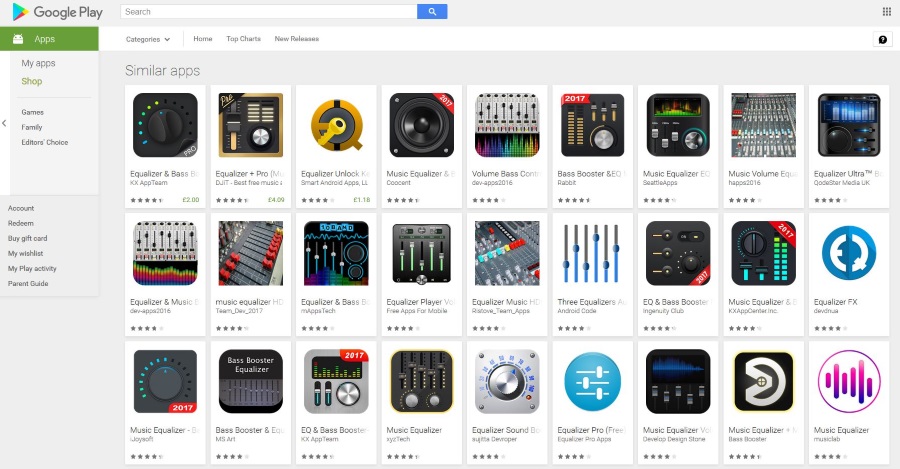
Though you probably use your smartphone in 2018 more than any other gadget, it was only ten years ago that you carried around an iPod with you at all times. The original series of iPods and, to a less popular extent, other non-Apple MP3 players, revolutionized how we listened and thought of music, and smartphones have only pushed us farther along that line. We’ve grown from carrying around a Walkman in the 1980s to portable CD players in the 1990s and 2000s, complete with a sleeve of discs to carry around at all times. That iPod you first owned in 2004 was the first time 1,000 songs or more could fit in your pocket, without having to change out disks or tapes, and in 2009, you upgraded to an iPhone or an iPod touch, which included all of your songs, plus your videos, photos, games, and so much more.
In 2018, everyone has a smartphone. Over three quarters of Americans own a smartphone, with the youngest generation adults ages 18 to 29 featuring over 92 percent of a smartphone adoption rate. That means that you’re probably on your third or fourth smartphone, and since you’re reading this article, it’s fair to assume you’ve adopted Android as your platform of choice. Though it’s inarguable that iOS was the original champ when it came to listening to music, bolstered by the strength of its inclusion of iTunes and Apple’s excellent music player, the rise of streaming services have basically caused the playing field to level out when it comes to listening to music. Every major streaming player is on both platforms—including Apple Music—which means it’s easy to choose any music service on the market today. You aren’t left out if you listen to local music either. Google’s Play Music app has the ability to store your music in the cloud for free, and there’s dozens of great-looking music playback apps on Android that can play your music regardless of file type.
But here’s the thing: just because you’re listening to your music on your phone doesn’t mean you’re getting the best music experience possible. If you want to get the most out of your music experience, no matter how you’re listening to it, you’ve come to the right place. There are several different variables that can influence how your music sounds when you’re listening to your mobile phone, from the file type and bit rate of your song collection, to the speakers or headphones you’re using, all the way to the model of Android phone you own. For those who want the best music experience in 2018, there’s so much to consider. From streaming to local, wired to wireless, and the addition of equalizers, we’ve considered every variable to get the most out of your playback. Let’s dive into the world of audiophiles and hi-fidelity: this is our guide to getting the best sound from your music on Android.
Does it Matter What Phone I Choose?
The first step to getting the best sound from your Android phone is to realize that not every Android phone is built the same. As we head deeper into 2018, more manufacturers are moving away from the traditional 3.5mm headphone jack. In addition to Apple, we’ve seen Motorola all but drop the headphone jack on its flagship devices, the Moto Z series. Google dropped the headphone jack from its 2017 devices, the Pixel 2 and Pixel 2 XL, despite originally using the headphone jack as a selling point in the advertising campaign for the first Pixel phone (hilariously, Google broke the news during their launch event by telling the audience you can use your favorite 3.5mm headphones with the included adapter, sidestepping the fact that they had originally sold the first Pixel as a phone with a headphone jack). HTC has dropped the headphone jack as well, with only Samsung and LG left as the major proponents of the traditional jack on their devices. Even smaller companies, like Razer or Huawei, have left the 3.5mm jack off their phone models.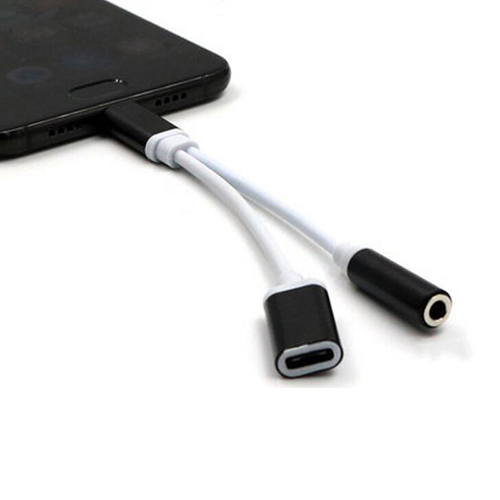
But perhaps this isn’t as big of a deal as some make it out to be. Yes, when done right, the 3.5mm headphone jack is a great thing to have on your phone. For one, you can pick up a halfway-decent pair of earbuds for less than $20, and more premium headphones from companies like Sennheiser or Audio-Technica sound incredible with their traditional 3.5mm headphone jacks. These headphones have been around for decades, and if treated right, a $400 or $500 pair of headphones will last you your entire life. Meanwhile, the market for USB-C headphones it virtually non-existent. Even Apple’s market for Lightning headphones has been disappointing, with most users focusing on either using the adapters that come with their phone, or using Bluetooth headphones from Amazon. We’ll discuss Bluetooth more in a section below, but let’s be clear: even the best Bluetooth headphones can’t hold a handle to a premium set of wired headphones. The audio difference is there, and for our burgeoning audiophile readers in the audience, you’ll want to focus on using your dongles when you can.
In some ways, losing the headphone jack isn’t the worst case scenario. For example, the 3.5mm jack on the original Google Pixel was notable for lackluster sound reproduction and static issues within the headphone jack, and the Bluetooth was just as bad. Some phone manufacturers, like HTC, have included some terrible dongles with their devices; the HTC U11 is a great phone, but the USB-C dongle that ships with it is notably terrible-sounding. But the Pixel 2’s dongle actually sounds pretty good—at the very least, better than the included headphone jack on the original Pixel. Giving up the headphone jack is a tough decision for a lot of people, but it is worth noting that this can occasionally increase the sound quality expected from your device.
For the purpose of this article, however, we should look at the device’s that do audio right. This doesn’t only mean phones with headphone jacks, but phones that focus on making audio quality and the sound of a headphone jack an important aspect of the device. You don’t need to buy a new device to get the most out of your music, but if you’re looking for a phone built for music, here are a few recommendations as you look to upgrade your device:
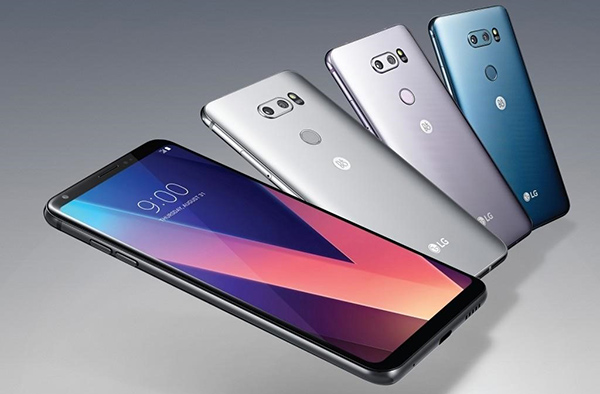
- LG V30: This is a music lover’s dream. Though we found the phone to largely be a bit of a mixed bag in terms of its entire package, the audio hardware in this thing is incredible. The V30 includes a quad DAC for playing back audio at levels we really haven’t heard on a mobile device before. Reviewers have cited the phone as being comparable to dedicated PMPs from companies like Fiio or Astell & Kern, and while you might not hit that sort of $1,000-level quality on the V30, the minor hit in quality between the two devices grants you all the utility of a dedicated phone. The V30 isn’t a perfect device—the camera is lacking, the display is weak, and the battery life can vary day to day—but when it comes to audio, this is the phone to use.
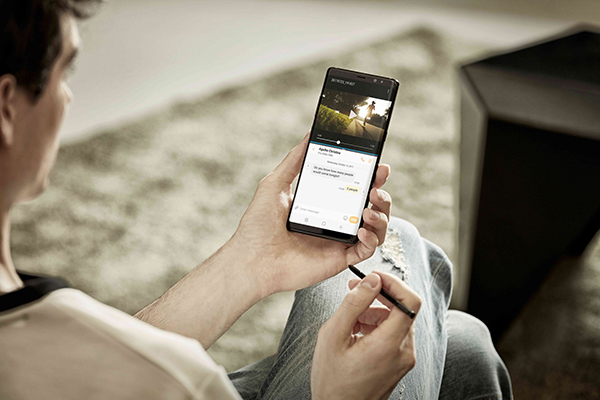
- Samsung Galaxy Note 8: The audio on this phone isn’t anywhere near what we’ve come to expect from the LG V30, but it is pretty solid in one major way: it, along with the Galaxy S8 and S8+, still have headphone jacks. These devices can be used without any type of dongle, and while the sound quality isn’t anything to write home about, we’d simultaneously be surprised if you were majorly disappointed. Millions of people buy these phones each year, and the inclusion of a headphone jack on these models is great news for consumers. Plus, both the Note 8 and the two S8 models are by far better overall devices over the V30.
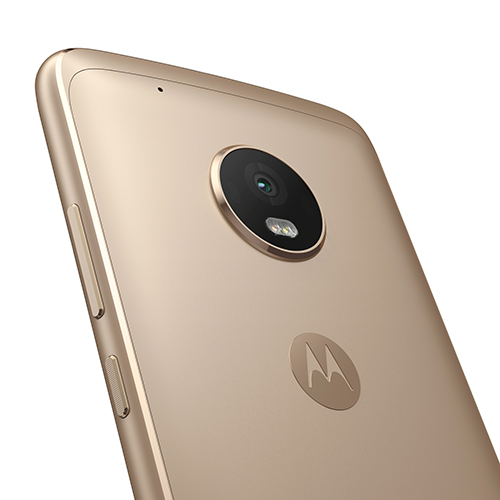
- Moto G5 Plus: The G5 Plus will likely be replaced by the Moto G6 in the first couple months of this year—likely at Mobile World Congress in February—but that doesn’t mean you should completely ignore the phone. The G5 Plus is available for under $300, despite the decent specs and hardware build, offering a solid-if-unspectacular music listening experience for anyone interested in keeping their headphones around. Those looking for a more premium smartphone experience could jump up to the newer Moto X4, a sub-$400 phone with a glass back and premium, Samsung-esque design. Unfortunately, the Moto Z series, with the brief exception of the Moto Z Play in 2016, has all but done away with the headphone jack, and we expect the 2018 Moto Z phones to do the same.
Though those are our top picks, they aren’t the only ones worth choosing. HTC’s 2017 flagship, the HTC U11, was previously mentioned. It’s a good phone with some solid external speakers, but those looking for a headphone jack should look elsewhere. If you’re truly interested in the U11, dump the included adapter and purchase the Pixel adapter from Google for $9. The international version of the LG G6 has a quad DAC similar to the V20 from 2015, but the Snapdragon 821 chipset in that phone is a bit too old to recommend at this point. You’d be better off waiting for the successor to the G6, presumably to be announced at Mobile World Congress like last year. The Pixels, as mentioned, have solid adapters included with their phones in the box, but they’re still adapters. The 2016 Pixels are some of the only Snapdragon 821 phones we’ll still recommend, though the headphone jack on those models are, as stated, pretty terrible. Overall, sticking to LG or Samsung for flagship devices or, if you wish, Motorola’s lineup of phones is the best way to go about it. Once you have your phone picked out—or if you’re looking to stick with the phone you already have—it’s time to move onto the most important step: playing music back on your phone.
Playing Your Music
The device is in your hand, but you aren’t even close to finished. While the hardware you’re using to listen to music through your headphones or in the car is important, the software can truly change how your music is heard. We’ll get more into the nitty-gritty of listening to your music down below—that is to say, everything from bitrate to file compression to using wired vs. wireless headphones—but for now, let’s focus purely on the actual, installable, interchangeable app side of things. Namely, the music app you’re using to listen to your music, and the equalizer you’re using to customize the sound of your music.
Music Apps
There are dozens upon dozens of apps to choose from to listen to music on Android. From streaming services like Spotify or Google Play Music, to local playback options like PowerAmp and Pi Music Player. It can be difficult to pick just one music player to use when there’s so many different options and choices to pick from, but one thing’s for sure: like phones, not every music application can do the same thing. Being careful to pick the right music player for you is incredibly important, although it’s important to keep in mind that choosing a music player is far more limited if you’re looking to pick a streaming service from the seemingly-endless market. Want to stream your music collection through Spotify? That’s fantastic, but you’ll be using the Spotify app to do it. Same goes for Apple Music, Tidal, Google Play Music, and anything other similar streaming services.
Local playback versus streaming music services is a whole discussion in and of itself, so for now, let’s focus on local playback applications. These are the pieces of software that can playback local files on your mobile device without any paid subscription. If you’ve amassed a library of downloaded and ripped music over the past two decades, these are the apps for you:

- Poweramp: We’ll say it. Poweramp is pretty ugly, at least in its current, default state. You can skin the app with a multitude of colors and designs, but as the saying goes, lipstick on a pig doesn’t change what lays underneath. That said, there are a few skins we can give the thumbs-up to that improve the overall app experience, including this pleasant-looking material design skin for Poweramp that makes the app quite a bit more enjoyable to use. Poweramp’s overall utility comes from its music playback skills. This app can play nearly any file type you throw at it, including the standard MP4 and AAC files you’ve gathered from online stores and CD rips. More importantly, however, is Poweramp’s support for lossless file types like WAV, FLAC, and ALAC (Apple Lossless, excellent to use for those of us who have chosen to switch from iOS to Android). Overall, if you deal with some of the jank that comes with Poweramp, as well as a slow update schedule, you’ll find Poweramp’s audio engine to sound fantastic.
- Google Play Music: Though Play Music qualifies as a streaming service offered by Google, it’s also the default music application on most Android phones, including the Pixel lineup and newer Samsung devices like the S8 and the Note 8. Play Music isn’t the prettiest or the flashiest music player in the world, but it’s pretty solid, offering equalizer support, free ad-supported radio stations (similar to Pandora, and a direct result of Google purchasing Songza in 2014). If you’re interested in having access to your local library of songs wherever you go, using Play Music is a no-brainer. With a solid web-client and the ability to upload up to 50,000 songs for free to Google’s servers, you can play back your collection no matter where you head in life. Google even supports uploading lossless files like FLAC and ALAC, though it’s worth noting that those files will be converted to MP3 format once uploaded.
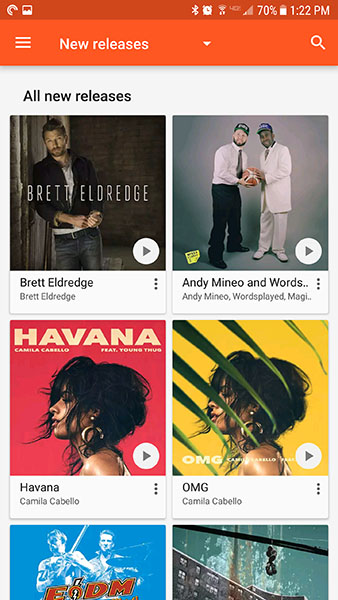
- BlackPlayer: One reason BlackPlayer ranks so high on our list is because of its gorgeous, minimal design. The dark theme looks great, especially on modern AMOLED displays, and the layout of the app makes it easy to browse for your exact song. BlackPlayer uses your phone’s decoder, so the file types accepted by the app depend on what device you carry on a day to day basis. As long as you’re using a newer phone, you should have support for standard audio files in addition to FLAC and AAC. BlackPlayer also includes its own equalizer, negating the point of downloading one of the equalizers we have listed below. If you like Poweramp but wished it had a bit more of a modern approach to design and function, BlackPlayer is for you.
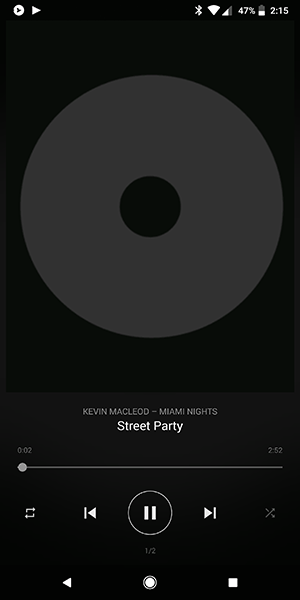
- jetAudio HD Music Player: Like Poweramp, jetAudio isn’t exactly the best looking app we’ve ever seen on Android. It certainly looks leaps and bounds better than Poweramp or other older audio apps, but the interface isn’t the reason to use jetAudio. With a number of plugins, enhancements, and other audio-based improvements built right into the application, jetAudio might be ideal for anyone looking to make the most of their library of classic albums. With the Plus version of the app, you’ll find a 20-band equalizer, a full tag editor, reverb and bass sound effects, 32 full equalizer presets, support for nearly every single kind of audio file you could imagine, and light and dark themes. For just $3.99, it’s one of the best audio apps for those of us who love to mess with the sound of our music.
- Neutron Music Player: Another not-so-great looking application makes our list, but for Neutron Music Player, it’s pretty easy to ignore considering Neutron’s abilities as a music player. Unlike most music players, Neutron has its own independent audio engine separate from Android, which, in theory, allows it to present better audio no matter what software is included on your mobile Android device. With support for both local and network music collections, the ability to play nearly every single audio file you can imagine, and 21 common equalizer presets. This is a professional-style music player, one designed for audio pros who know their stuff. Between the general complications and the interface of the app, this is one music player that many may skip out on. But for those that like what’s delivered here—and can deal with the dated interface—you’ll find a lot to love.
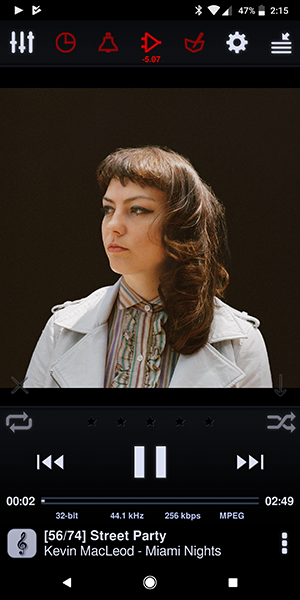
As we mentioned, those who decide to go the streaming route can more or less skip over picking a local music player. When it comes to picking a streaming service, however, you’ll want to stick with us, as we’ve dived deep into the audio quality of all the major streaming players in our Listening to Music section below.
Equalizers
If we’re being completely honest, an equalizer probably isn’t the most important thing in the world when it comes to perfecting your music sound on Android. In fact, when it comes to listening to music on mobile, you might actually do more harm than good with an equalizer if you’re inexperienced in tuning high and low frequencies to your liking. Typically, your phone comes tuned in a way to make it sound good with all audio, from hip-hop to pop, country to electronic, and even podcasts and audiobooks where voices are the primary sound you here when listening. Still, the reason most people seek out equalizers are simple: this all-around tuning method means nothing ever sounds perfect. Hip-hop relies on a heavy bass for its beat, for example, whereas a heavy bass sound when listening to NPR can drown out and muddy heavy voices. Equalizers become great for tuning your music to one sound, and adjusting as need be.
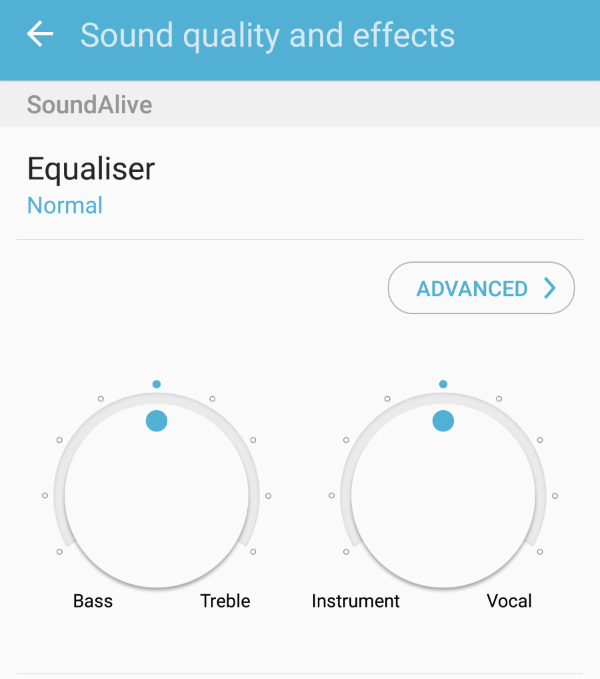
Not every phone has a built-in equalizer, which means you’ll need to look to the Play Store. Some devices, like Samsung’s Galaxy S7 and Galaxy S8, including equalizers by default, accessible in the phone’s settings menu by diving into the app’s settings. Other phones, including Google’s Pixel series, use a standard Google-made equalizer that’s, overall, pretty basic. If you want to see whether your Android phone has a preinstalled equalizer included in the app, dive into Google Play Music, included by default on every modern Android phone. Inside of the settings menu, you’ll find an option to select “Equalizer” under your playback settings. If the menu selection isn’t there, or it’s greyed out, you may not have an applicable equalizer included by default in your phone’s system software. Otherwise, click the setting. This will load your system EQ, which provides you with a number of options. Samsung’s EQ, seen above, gives dials for Bass and Treble, as well as Instrument and Vocal, and a preset option for selecting a from a number of differen variations of sound. A more traditional equalizer, complete with frequency sliders, is accessible through the Advanced tab.
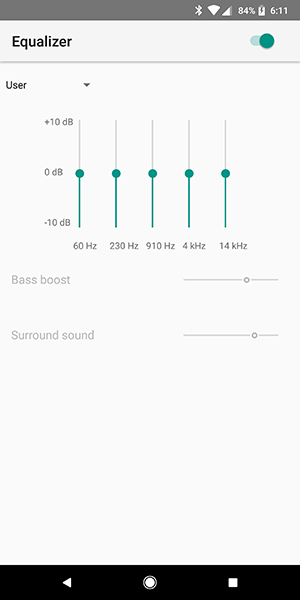
The Google-built equalizer, on the other hand, is far less complex. Gone are the dials for instrument and vocal tuning, and in its place is a basic five-slider EQ, built to allow adjusting frequencies on a low-to-high volume. This isn’t anywhere nearly as powerful as what you’ll find on a computer or in some music applications, including Poweramp, but as a free option, it’s surprisingly useful. As with all EQs, lower frequencies on the left of the graph affect your bass, while high frequencies on the right affect your treble, minimizing or maximizing your experience as you adjust your sliders. Like Samsung’s equalizer, Google’s allows you to automatically select a preset EQ setting for your genre of music. There’s a wide variety of options here, ranging from classical to dance, Rock to pop, and jazz to hip-hop. These options automatically set each of the five frequencies to a standard setting, which allow you to get the best sound for your music. At least on our test device (a Pixel 2 XL), the EQ works on the phone speakers, but the options for bass boost and surround sound won’t turn on until a pair of headphones or speakers are attached or synced over Bluetooth.
If you head into your settings inside of Google Play Music, but you’re unable to view an equalizer in your settings, you have a few options to add onto your device through the Play Store:
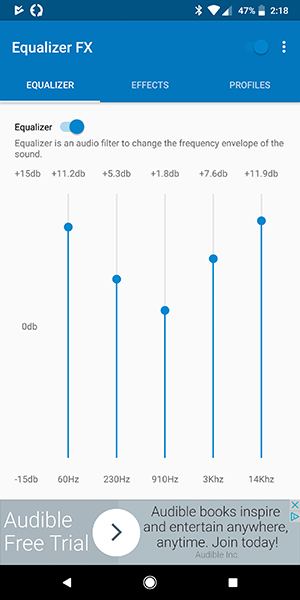
- Equalizer is, in many ways, the app you’ll want if your phone doesn’t include a powerful-enough equalizer for your tastes. Though the app has gone without updates for several years (dating back all the way to 2014), there’s still a ton of reasons you should use this app. For one thing, the visual design, though dated, manages to hold up well enough against most of the other equalizers on this list. The app gives you several presets that allow you to automatically change how your music sounds on the fly. There’s no ads to speak of here, though some of the more advanced features, including fine tuning with the EQ graph, is locked behind a paywall. The age of this app means it might not work on newer phones, so it’s important to try out the features before paying for an upgrade. We don’t expect Equalizer to see any future updates at this point, but it remains a solid offering on the Play Store.
- Equalizer + Pro occasionally feels like a successor to Equalizer, kept up to date and featuring a cleaner, more modern user interface. Though a free version does exist, we recommend going with the $2.99 Pro version of the app, which gives you the experience without any in-app purchases or advertisements. In addition to a Bass Boost mode, Equalizer + Pro includes a visualizer that plays along with your audio stream, a DJ mode that removes gaps between your songs (depending on your player), and the ability to save your custom presets. This is all in addition to the 7-band equalizer you gain access to with the free version, along with the 10 presets delivered in the app. Overall, we found Equalizer + Pro to be a solid offering in terms of what you’re getting for the cost, and is absolutely worth the investment.
- Equalizer FX is like the modern version of Equalizer, presenting a basic, easy to use equalizer in a clean, Google-esque package. The basic app provides you with a five-band equalizer, just like Google’s own standard version, that allow you to adjust the strength of your bass and treble. Equalizer FX includes 12 different presets, a good amount for the entry price of $1.99, and allows you to set a number of widgets on your homescreen to control your sound without having to open the app. A loudness enhancer can help on a plane or when you’re mowing the lawn, which is great news for those of us who work outside while listening to music. If there’s one major complaint about Equalizer FX, it’s the lack of support for additional audio bands, something fans of the application seem to wish was standard. Still, this is a clean, well-designed app and perfect for anyone just getting started with equalizers.
- Music Volume EQ is a solid, if slightly underwhelming equalizer that uses a skeuomorphic design to look like equalizers you’ll find in a professional studio. The app includes a standard five-band equalizer just like Equalizer FX and the stock Android EQ, along with a typical bass boost and a gain control to bump your volume. There are some additional settings that will allow you to tweak the look and feel of the app, and a music visualizer helps determine if a frequency is peaking or not. A helpful widget can allow you to control the sound right from your homescreen, which saves you the trouble of diving into the app to fix a setting. Unfortunately, the app is ad-supported without the option to pay to remove for ads. Music Volume EQ suggests using Bluetooth headphones with the app, so if you’re the owner of a phone without a headphone jack, you may find it the most useful of the bunch.
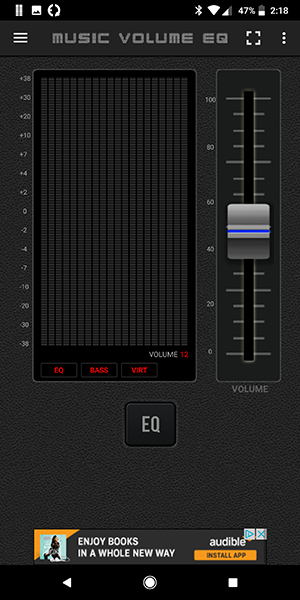
With each equalizer, you’ll want to ensure it works with the music application of your choice before you pay for an upgrade. If you do purchase an equalizer that doesn’t work with your player, remember that Google Play will let you refund a paid app within the first fifteen minutes of your purchase in most cases.
Listening to Your Music
You’ve chosen your phone. You’ve chosen your music application, and you’ve decided on an equalizer. But now that it’s time to listen to your music, you might realize you aren’t even close to finished deciding which settings to choose and which to ignore. Should you use wired headphones, or switch over to a Bluetooth-enabled set? If you’re looking to stream your music over the internet instead of listening locally, you’ll need to pick a service that provides the best audio—but which one does? Should you buy a Bluetooth receiver for your home speaker system to stream from your phone, or is Chromecast Audio the better option? All of this and more is answered below, so let’s dive into the best ways to listen to music on Android!
Wired vs. Wireless
For some users, you might not have much of a choice when it comes to listening to your music. Owners of the Moto Z2 Play or Google Pixel 2 can choose to use wired headphones, but they’ll have to do it at the cost of their USB-C charging port. Still, choosing between wired and wireless audio is a choice basically every smartphone owner can make, no matter whether they own a brand new Pixel 2 XL or a Galaxy S8+. If you’re looking to pick between picking up a new set of wired headphones or to cut the cord completely, here’s the pros and cons of each option:
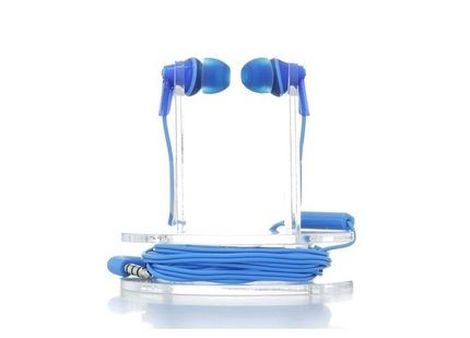
Wired
Wired headphones are available at any price range, from $9 to $999 depending on which set you pick out for your daily use. The benefits to using wired headphones are obvious and notable. The 3.5mm headphone jack has been around for the better part of a century, and it’s a miniature version of technology dating back to 1878. While the argument of age has been used by Apple and other companies to argue for moving forward from the jack, the ubiquity of a standard headphone adapter means it’s on everything. From the headphone jack on your laptop to the aux port in your car, nearly every gadget or technology item you own today has some kind of support for the 3.5mm port. It also means that every corner store and gas station has 3.5mm headphones available to be used if you ever forget your headphones on the way to the gym.
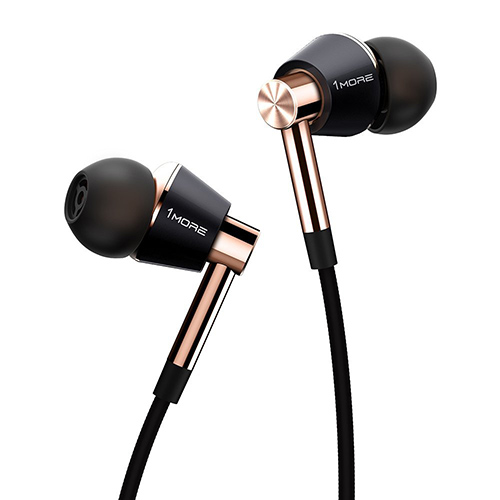
As mentioned, the price tag of earbuds is also notable. You can get pretty solid sound for not a lot of money. Some $20 earbuds actually sound pretty fantastic (and others, of course, sound terrible), and for less than $100, you can pick up some incredible earbuds. For those who prefer on-ear or over-ear headphones, Audio-Technica’s ATH-M50x model are legendary for their sound balance, and can be had for less than $150. Sennheiser’s line of studio headphones are a bit pricier, but sound just as great and come with some premium design choices. Of course, the headphones you decide to use are really a personal choice, but the variation is there, allowing for anyone to find the right fit, comfort, style, and sound at their own set price range.
All of this doesn’t mean wired 3.5mm headphones are perfect. For one, the general size of the port can be a problem. It does take up a portion of your device’s internals that can be used for everything from additional battery capacity to different adapters and vibration motors. The length of the adapter also means that accidentally pulling the cable out can permanently damage the port. There are also arguments that could be made towards the age of the port making it obsolete, and moving to digital audio through USB-C can be seen as an improvement, but digital audio can bring along a number of its own issues, including the possibility of DRM-ridden audio streams. Still, in the eyes of most, analog 3.5mm headphones are still the gold standard for quality and affordability, and if you’re lucky, sometimes both.
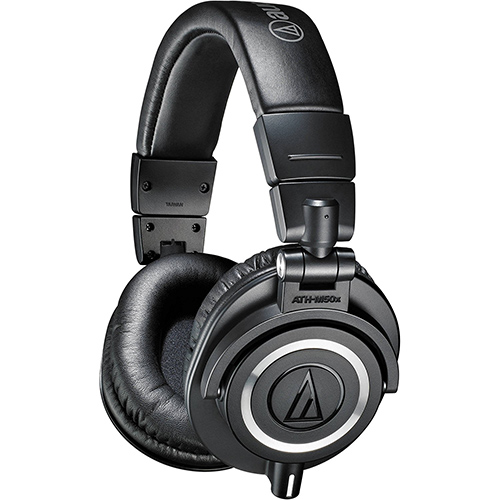
Wireless
Ever go for a run while wearing standard earbuds, or try to work out at the gym while lifting weights and getting pumped to Big Sean? It’s not like wires make physical activity impossible, but once you’ve tried wireless audio at the gym, you won’t want to go back. The ability to keep your phone in your hand, or nearby while you’re at a bench, is worth the hassle of pairing a phone over Bluetooth. It’s one of those things that seems so slight, but once you’ve tried it, you won’t want to go back.
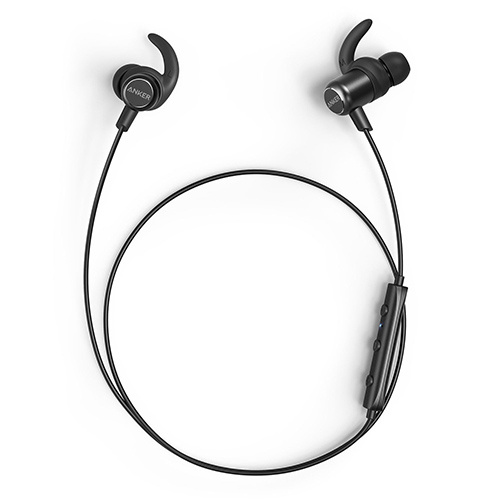
Bluetooth earbuds are mostly falling in price. Headsets from the likes of Anker or SoundPEATS can be grabbed for $15 to $40 through Amazon, each with their own specific function or feature. Battery life is also improving on the “neckbuds” models, which typically have a piece of plastic wrapped around your neck or a simple wire running between the two earbuds. Newer models can reach up to 7 or 8 hours of battery life. Anker, in particular, is pretty good at the battery life game. While the majority of their neckbud models reach about eight hours of battery life, their Anker SoundBuds Curve model has a rated battery of 12.5 hours, enough to make it through a full 8 hour work day and an hour-long workout at the gym. Pretty solid stuff, all things considered. Audio quality has also improved on these models; it’s nothing amazing, and can certainly be beat by a good, well-rated pair of wired earbuds, but if you’re used to picking up JVC Marshmallow earbuds at Walmart for $10 or so, paying the extra $10 for wireless models will net you a similar audio quality.
Unfortunately, the non-neckbud models haven’t made a ton of progress in the battery life arena, and their sound is still pretty terrible as well. Really, only Apple’s own Airpods have found any success as completely-wireless earbuds, with most competing models having some flaw (poor connections between the left and right channel, terrible battery life, abysmal sound or mic quality), and considering that most of the advantages to owning the $159 Apple AirPods don’t work outside of iOS and MacOS, meaning they’re largely useless to Android devices. And while you can pick up wireless earbuds with 8 hour battery life ratings, and wireless over-the-ear headphones with 20-plus hour battery life ratings, you’re still going to have to add another gadget to your list of things to charge every night. And if you happen to forget to charge your earbuds before heading to the gym, it’s gonna be a long run for you.
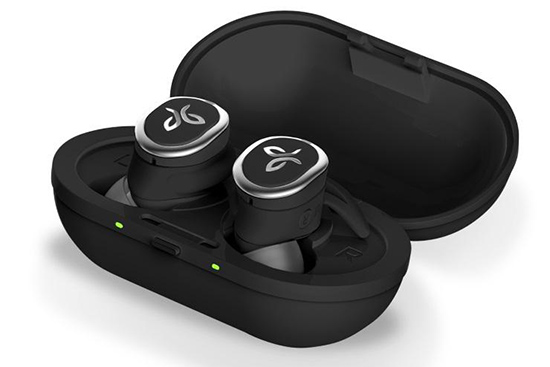
Ultimately, wired headphones represent an easier, more affordable, and largely better-sounding experience, but in certain circumstances, switching to full wireless Bluetooth headphones can actually be a decent trade-off. Sound quality isn’t as much of an issue as you might think when it comes to using wired versus wireless headphones, and although Bluetooth hasn’t quite caught up to the highs we’ve come to expect from a great pair of wired headphones (or even earbuds, for that matter), the gulf dividing the two has closed considerably over the past half-decade. It’s not unreal to use Bluetooth earbuds as your daily drivers, though you’ll have to deal with the increased size and charging habits of changing to a new set of buds.
Local vs Streaming
In 2018, a huge percentage of music listening is done over streaming options. Between Spotify’s free ad-supported desktop tier (with limited mobile streaming and cheap $5/month plans for students with access to both Spotify Premium and Hulu), Apple Music’s domination on iOS, and other competitors like Google Play Music (which offers free cloud-uploads of your entire local library), Pandora, and Tidal, there’s no shortage of music streaming options on the market today. But here’s the thing: depending on your streaming settings and what service you’re listening to your music through, you might be sacrificing some amount of sound quality to use data to listen to your music. We already discussed local playback above, so you should keep in mind that your local playback can largely depend on a number of factors, including bitrate and compression format. That said, if you’re ripping your music off CDs or downloading lossless versions of your music from stores like HDTracks, you should find that the sound quality played back on your device, particularly if you’re using a solid local playback app like Poweramp, will be better than a streaming service ever could dream to be.
Still, streaming music is the way most people listen to music in 2018, so here’s a quick roundup of the most popular services and whether or not they’re known for having particularly strong audio quality on Android:
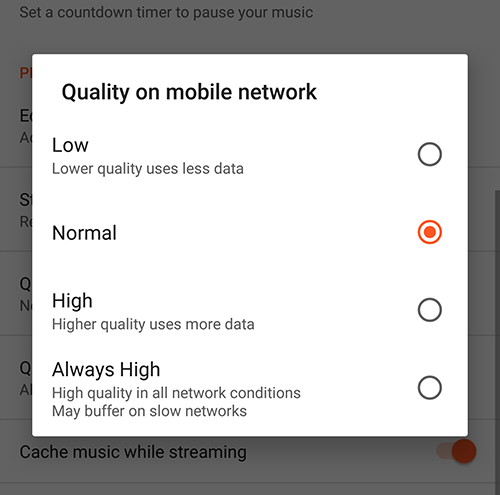
- Spotify: A YouTube replacement for many college students and office workers alike, Spotify has largely become the default music player for millions of users because of its free tier. Ask any Spotify user, however, and they’ll openly admit that the app comes with its fair share of limitations. If you’re using the free version of Spotify on desktop, your audio is set to 160kbit/s using the Ogg Vorbis format. On Android, however, your audio quality will be set to “Normal,” limited to just 96kbit/s in Ogg Vorbis. This isn’t terrible, and because Spotify uses Ogg Vorbis, you’re likely to hear better quality than a 96kbit/s MP3, but you’ll need to pay to gain access to better audio. On the Premium plan, Spotify can stream and download up to 320kbit/s on Extreme mode in Ogg Vorbis format. It won’t be lossless quality, but there will be a noticeable boost in quality over something like, say, Normal mode.
- Google Play Music: As the default music app on Android, Play Music users are more likely to subscribe to the service than an iOS user might be. Here’s the good news: like Spotify, Google Play Music has a toggle in settings for quality levels of music for both streaming and downloaded songs. Setting the option to High or Always High will sound better than Normal or Low quality, but at the same time, the app does a really poor job in illustrating what you should expect from the quality level. In general, the high setting sounded similar to the Extreme option on Spotify (320kbit/s), and you can assume the bitrate is identical, if not similar.
- Apple Music: Thanks to the ability to sync your iTunes library through the cloud, Apple Music has its fair share of fans on Android. The app perhaps isn’t ideal for those looking for a perfect Android-exclusive experience, but here’s the good news: the quality doesn’t take a dip from typical iOS levels of quality. Apple products, from the iPod to the iPhone, have never been about hi-fidelity audio—perhaps Apple left that back in the 1990s with the failed Apple Hi-Fi—but quality is usually above average from the music service. Unlike Google and Spotify, Apple doesn’t allow its music service users to change the level of audio quality music is streamed through, instead keeping it at a perfectly-acceptable 256kbit/s bitrate with AAC encoding.
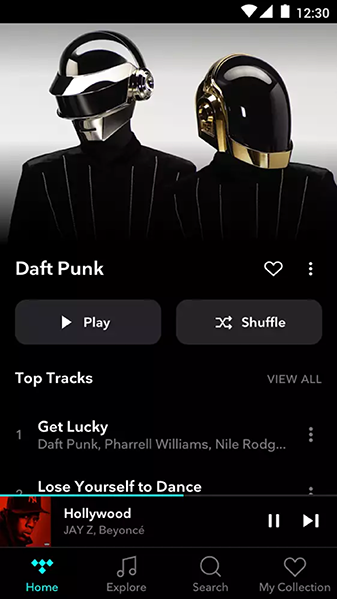
- Tidal: Tidal’s whole selling point has always been its audio quality, supposedly offering a much-higher premium over the likes of Spotify and Apple Music. For its standard $9.99 plan, you gain access to a 320kbit/s stream encoded in AAC, which will sound better than the offerings from Spotify using Ogg Vorbis. That said, if you’re really into the sound of your streaming music, you’ll need to pony up your cash for the $19.99 per month “Hi-Fi” plan. While double the price of the standard streaming plan on this list, you’ll gain access to both FLAC and ALAC tracks streaming and downloaded at a fantastic 1411kbit/s download rate. Make sure you have headphones or speakers that can take advantage of that quality audio before you jump up to the Hi-Fi tier.
- YouTube: YouTube’s been emphasizing their influence in music streaming for a long time now, as evidenced by its creation of the YouTube Music app, YouTube Red’s ability to save songs offline, and the inclusion of YouTube videos inside of Google Play Music. Here’s the problem with YouTube when it comes to listening to music: because the quality of the content depends on the uploader and what file they use, you’ll likely never find anything better than a standard, 320kbit/s song upload (if that). Even if a video feature a lossless version of a song is uploaded to the service, YouTube’s compression engine will, unfortunately, likely lower the quality of the audio. The way to look for the best audio on the service is to browse for videos uploaded in 1080p or higher. On YouTube, better video quality also equals better audio quality; if you don’t believe us, go watch a 240p video and listen to the compression on the sound. Still, for those looking for consistent sound quality, you might want to look beyond YouTube.
- Pandora: The web’s original free audio streaming service, Pandora has expanded from an internet radio broadcast to a full-on Spotify replacement. While plenty of users have left the radio service behind, some are resistant to change and remain with Pandora’s classic recommendation engine. Unfortunately, we have to advise that those of us looking for audio quality in their streams on Android skip Pandora for now. The highest audio tier on mobile, even with Pandora’s $9.99 premium plan, provides users with only 192kbit/s audio. Pandora told PC Mag in September that 320kbit/s streams on mobile were on their way, but for now, use one of the other services that provides higher fidelity audio streams.
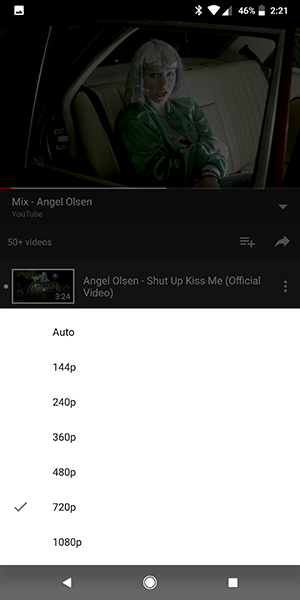
If you’re looking for a simple answer, our suggestion here is to stick with either Spotify, which offers good quality at a fair price, or to jump right up to Tidal’s premium plan if you’re looking for the best quality possible. That said, pretty much every modern standard outside of Pandora (and YouTube, which is something of another story) offer 320kbit/s streams, so you can stick with your current plan if you wish.
Bluetooth vs. Cast
When we talk about listening to music wirelessly, 99 percent of the time we refer to Bluetooth, even if it’s not explicitly made clear. But Bluetooth, though the main wireless interface most consumers find themselves using in day to day life, isn’t the only audio standard on the market today. Though you can’t use it while you’re on the subway or headed to work, Google’s Cast standard is an excellent way to listen to music around your house to Cast-enabled speakers or, barring that, a $35 Chromecast adapter. Though originally designed for content like Netflix and YouTube, Google’s Cast system actually sounds pretty good as long as you aren’t directly mirroring your device’s screen over your network. In 2015, two years after releasing the original Chromecast devices, Google released the second-gen Chromecast adapter, along with a new device: the Chromecast Audio, a small, record shaped adapter with an aux-out port that plugs into your existing speakers.
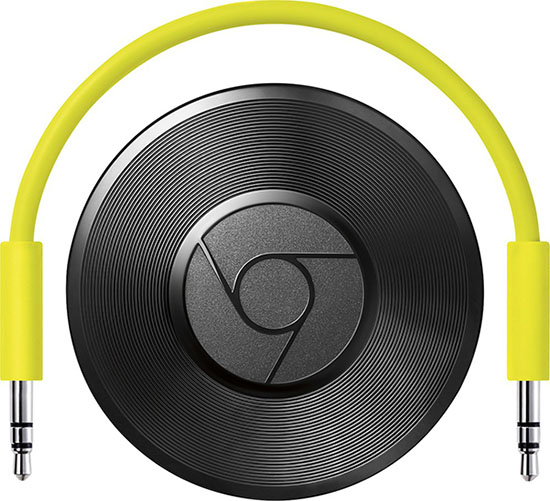
There are several reasons to rely on Cast over Bluetooth for your home stereo system, though it’s important to remember that the device itself requires a WiFi network to work properly. Once you get over that speed bump however, you’re likely to find Cast a much more rewarding system:
- A Chromecast Audio unit is, so long as it’s always plugged in, always on and available. While you may have to work on ensuring that the stereo is always on when you need it—may we suggest a Google Home Mini and a smart plug that allows you to turn the stereo on with your voice—you’ll like find that the device is far more reliable that Bluetooth. No syncing, no powering on, no holding buttons. It just works.
- Speaking of syncing, so long as you’re connected to the same WiFi network as your Chromecast or Chromecast Audio, you’ll find that your phone is always ready to connect to your stereo. Most major music apps, including those listed above and most major streaming services, have some level of support for streaming music from your phone to your speaker set. A Guest Mode also makes it easy for anyone, on your network or not, to connect to your device. At parties or holidays, it’s ideal for streaming content.
- If your app doesn’t have direct support for Chromecast, the Chromecast Audio unit allows you to cast any sound from your phone without issue. It’s actually pretty neat: unlike with the traditional Chromecast unit, the Audio unit can focus the entirety of its processing power on casting your audio, which means there’s no major sound issues when it comes time to cast audio from unsupported apps, including Amazon Prime Music (or Music Unlimited) and Apple Music.
- Speaking of audio quality, you’ll likely find that Chromecast and Chromecast Audio both sound better than your average Bluetooth receiver. This isn’t to say that Bluetooth speakers can’t compete on the soundfront quality, but if you’re looking for the best wireless sound for your home-based speaker set, you’ll want to go with Chromecast and, more specifically, Chromecast Audio.
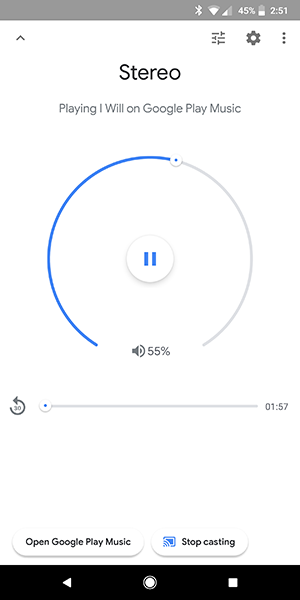
The biggest downfall to Chromecast’s audio standard is the reliance on WiFi, but at the same time, that makes some sort of sense as well. As mentioned above, the WiFi capabilities means the device is always ready to go, without the need to sync or reconnect to your phone. Instead of streaming from your device, Chromecast simply grabs a custom URL with the content you asked for from the internet, and begins playing that content back to you on your device, able to be controlled with your phone or with Google Assistant. The biggest problem with Chromecast comes from its occasional forgetfulness; because your device isn’t actually playing music, Android will sometimes forget something is being played on its network. The audio will continue to playback, but you may find reconnecting to the device difficult or frustrating. Still, Chromecast offers an overall superior wireless experience to Bluetooth so long as you’re streaming in an area that has WiFi support. It’s a solid option for anyone looking for a better standard than Bluetooth, but forget about picking up a pair of Cast-enabled headphones.
***
If it isn’t apparent, a lot of different factors go into powering your audio experience on Android. From the music application you use, to your headphones (and whether they’re wired or wireless), to the very phone you hold in your hand, there are countless variables that can change your experience for the better—or for the worse. For the average consumer, a lot of this may seem like overkill. You probably don’t need to pay for a Hi-Fi account from Tidal, nor do you need to purchase an LG V30 over other smartphones on the market today. Most consumers can experience quality audio by picking up a decent pair of wired headphones, ensuring their streaming services are set to high (or by ensuring that you’re using audio tracks at a 320kb/s bitrate, if you don’t plan on using a streaming service).
Only 20 years ago, audio quality for digital tracks was terrible, requiring you to either use expensive software to rip content from CDs, or downloading low bitrate tracks off of online music stores like Ritmoteca or, with some less legality, Napster. Increases in digital fidelity, along with faster internet connections and improvements to mobile devices, have made it possible to carry your favorite songs around with you at higher qualities. Even if you decide not to upgrade to an LG V30 with $500 headphones and the most expensive Tidal plan, you’re still getting better audio than ever thanks to quality of life improvements in audio. And frankly, the general increase in audio quality for average consumers is great news for the music industry. While plenty of people still use their Apple Earbuds or rely on the headphones in the box, more and more users are paying attention to basic music quality. That’s good for the industry, good for musicians, and most of all, good for people who love crips, quality sound.

















One thought on “How To Get the Best Sound from Your Android Phone(Apps, Equalizers, and More)”